How to Draw a Human Body in Proportion
In this human torso drawing tutorial, you'll acquire bones human being body outline drawing techniques. If y'all've practiced capturing free energy in the previous tutorial, you'll take acquired a skillful feel for loose sketching of people. We're going to starting time giving structure to that feeling-based groundwork past studying the trunk with a more scientific eye.
Let me say that it will have many sessions to cover the wonders of the human body. Not just is it among the most sophisticated animal structures in nature, information technology is as well i of those with the well-nigh variations: few other species come up in and so many shapes and colors. Nobody, therefore, should feel frustrated for having trouble drawing people; it is an aggressive undertaking.
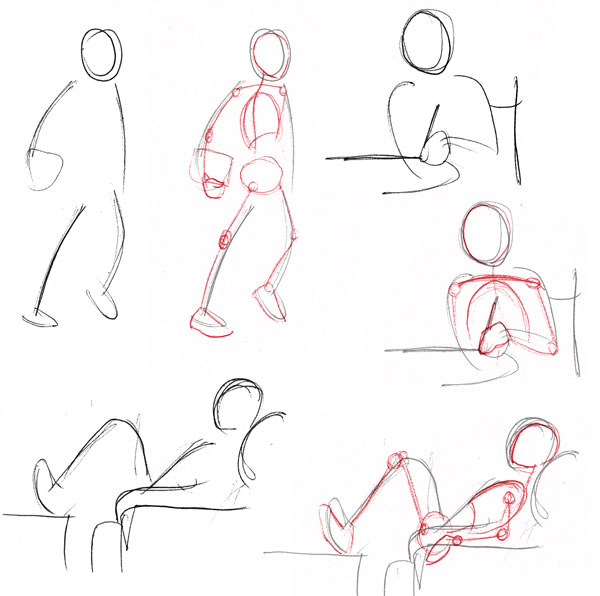


We're going to build upwardly this skill from the ground up, in the same order as the cartoon process, starting with a simplified torso drawing skeleton (the bones figure or stick effigy), moving on to the volumes of muscle structure, and then finally the details of each part of the torso and face.
The first central skills to larn are man proportions drawing techniques. And we're going to be practicing with this basic figure for a while to go familiar not only with the conventional "ideal proportions", but too with the way they vary with gender, age, and even indigenous background.
If you're drawing digitally, mayhap you want your work to look as if it's created with pencil and paper. If this is the instance, may nosotros recommend ane of the many Photoshop castor sets bachelor on GraphicRiver, including this Classic Fine art Castor Pack.



What You Will Larn in This Human Body Drawing Tutorial
- How to draw the human torso step by footstep
- Basic human torso outline cartoon
- Human profile drawing techniques
- Homo body proportions drawing
- Body drawing practice exercises
How to Draw a Torso: The Bones Figure
Create Your Chart From Heads
Allow's begin with man drawing nuts. A well-proportioned effigy, regardless of variations due to gender and such, is defined by the alignment of the joints, which is invariable (that is, we perceive something odd if it does vary). This is our groundwork for proportions. Depict your ain chart with me as we get—it really helps with learning the material.
To acquire how to depict a body, we showtime with the head. Outset by drawing an oval or egg shape (pointy end downwards) for a caput, and mark down eight measurements, the last 1 being the ground.
The measurement (platonic male superlative = viii heads) was set down during the Renaissance as an idealization of the human class. It's rather obvious that very few people are actually 8 heads tall (even Northern Europeans, who served equally the ground for this model, are closer to vii heads), but this is still the best model to beginning with, as it makes it easier to grasp the alignments.
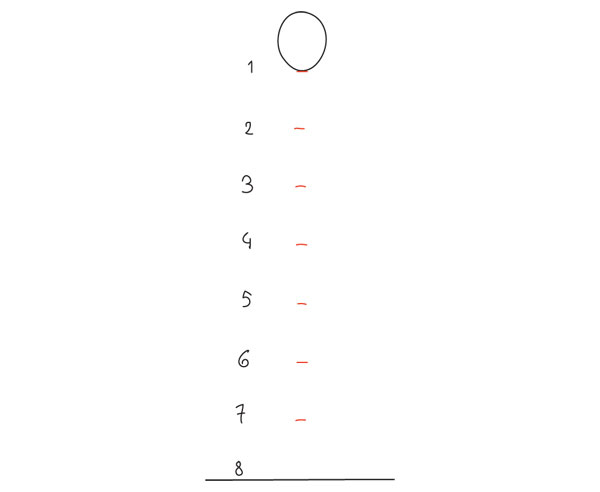


The Pelvis
Add the pelvic bone adjacent, simplified equally a flattened circle betwixt marks 3 and iv, with the hip joints sitting on 4. Its width is roughly 1.v to 2 head-widths. You lot tin now draw the spine connecting the head to this most important office of the torso, its heart of gravity and stability.
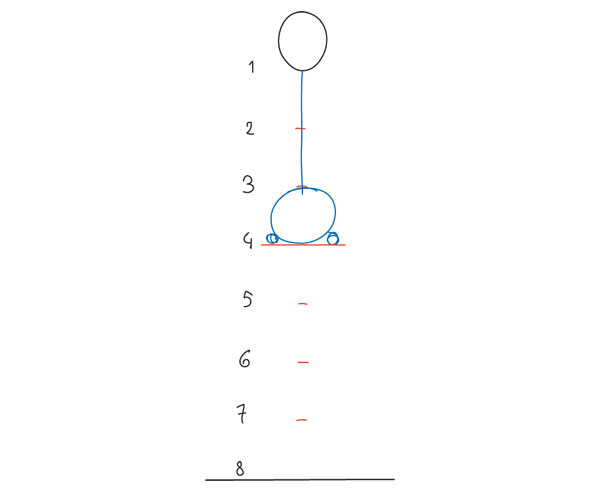


The Legs and Knees
Let's assume this effigy is continuing with the anxiety vertically aligned with the hip joints. The human knee joints sit on mark 6, as that line corresponds to the bottom of the kneecaps.
When the leg is stretched out, the articulatio genus joint is placed on a straight line with the hip and ankle (left). But this straight line is virtual: to complete the leg, connect the hip joint to the within of the kneecap, and and so again, the outside of the genu to the inside of the ankle (right). This is a very simplified but accurate representation of the actual bone structure, and it helps in drawing the natural look of the human leg, which tapers in from the hip, then staggers out at the knee, and tapers in once more. Information technology also helps with placing the muscles at a later stage.



The Ribcage, Nipples, and Abdomen Button
The ribcage-lungs grouping is the third of import volume of the body, later on the caput and the pelvis. Simplified, it is an oval that starts halfway between 1 and 2, downwardly to marking iii; but it is all-time to chop off the lower office of it every bit shown hither to imitate the bodily rib cage, every bit the empty part between the 2 volumes is of import: it is soft and subject to change (apartment belly, soft belly, wasp waist) and it is also where the near torsion and movement happens in the spine. Information technology's good to be aware of that and non to attach the torso and pelvis together like ii blocks, equally that would "block" your drawing'due south range of move. The width of the oval is roughly the same as the pelvis for now.
Two more than details here: the nipples fall on marking 2, just within the sides of the head, and the belly button on marker 3.
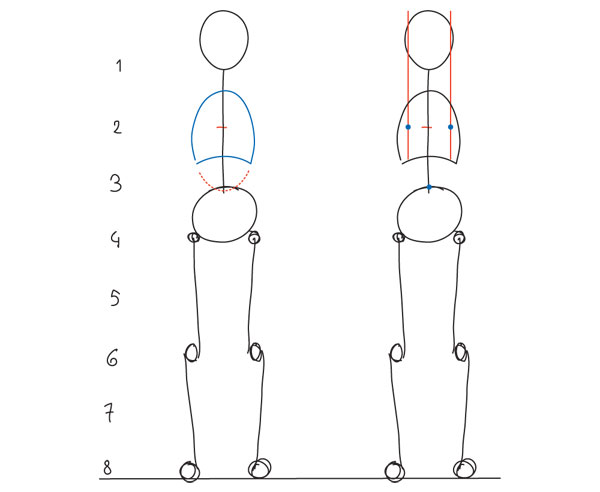


The Shoulders
The shoulder line is nearly halfway betwixt marks 1 and 2, with the shoulder width 2 to three caput-widths, but its apparent position can vary a great deal. To begin with, information technology's slightly curved down, but in tension the shoulders tense up and the curve can itself turn upwardly and await higher. Furthermore, the trapezius muscle, which from the front appears to connect the shoulder with the neck, is highly individual; if it'due south very muscular or carries much fatty, information technology can make the shoulder line look and so loftier at that place's no neck; inversely, an underdeveloped trapezius, oft seen in very young women, gives the impression of a long neck.
This brief digression into not-skeletal details is to ensure in that location'south no confusion between the actual position of the shoulder line and its apparent placement in a fleshed-out body, some examples of which are shown below.


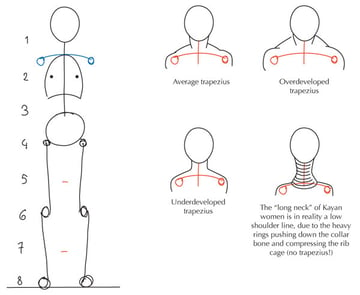
The Arm, Wrists, and Hands
Finally, the arms. The wrists are on mark 4, slightly beneath the hip joints, which sit on it (you tin can exam it out for yourself past continuing upward and pressing your wrists against your hips). The fingers end roughly at mid-thigh, which is marker 5. The elbows are a slightly complicated articulation that we'll examine in detail after, but for now it's helpful to marking them as elongated ovals sitting on level three.
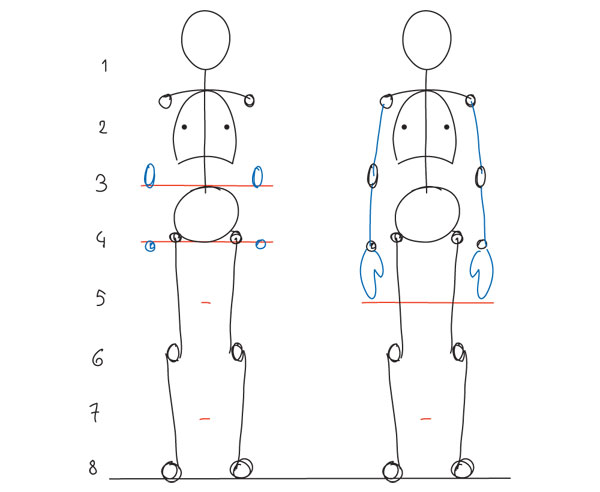


Nosotros're washed... almost. Before summing this upwardly, let's extend those marks into lines and see how this works in profile.
How to Depict a Trunk: The Bones Profile
The next step in learning how to describe a trunk is the profile. Beginning past drawing the head once more, the same egg shape only with the cease pointing diagonally downwards, and drib a vertical line from the crown to the ground.
In an erect posture, you tin place the pelvic os (a narrower version of the head'south egg), the shoulder, and the knee roughly on this vertical line. They are on the same level as before: all the joints are, but the others are non on the same plane equally these.
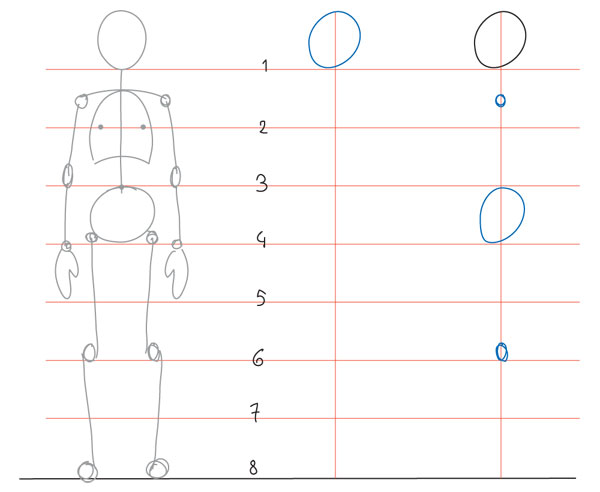


The Spine in Contour
From the side, the spine is revealed as existence shaped like a flattened "S". From the base of operations of the skull, it moves down and back till it reaches its furthest betoken at the level of the shoulders (between the shoulder blades). Annotation the shoulder joints are ahead of the spine! This is because, again, the shoulder "line" is in reality an arc: the medallion shows a top view of it.
The spine then comes back forward, and peaks once more (inwards) a little above the pelvis (the small of the dorsum, which varies in depth and tin make for an arched back). Finally it changes management again briefly and ends in the coccyx or tailbone.
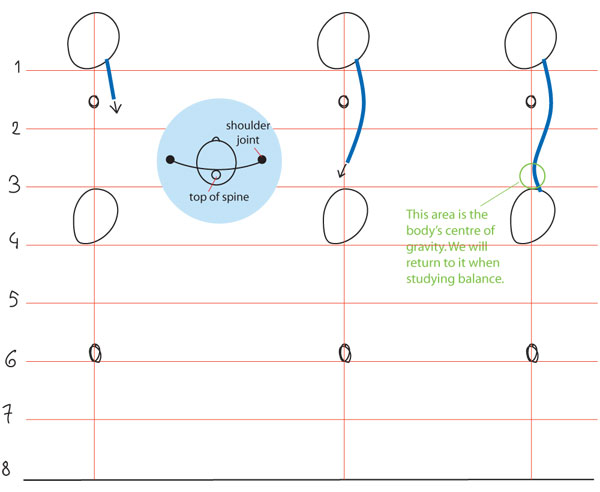


The Ribcage and Legs in Profile
The ribcage is closely fastened to the spine, and, in a reasonably fit body continuing erect, the chest is naturally pushed forward.
The hip joint is ahead of our vertical axis, and this is balanced by the ankle being a flake behind it. So our hip-knee-ankle line is slanted backward, and staggered again: from the hip joint to the front end of the knee joint, and from the dorsum of the knee joint to the ankle.
The overall consequence of this posture is a visual arc from head to chest to feet (in greenish), and when information technology's flattened or reversed, nosotros perceive an incertitude or slouch in the posture.



The Arms in Profile
Finally, the arms. The upper arm falls fairly straight from the shoulder, so the elbow can be aligned with the latter (or fall slightly backward). But the arm is never fully stretched when at rest, so the forearm is not vertical: the arm is slightly bent, and the wrist falls frontwards, right over the hip os. (Besides, when the hand is relaxed, the fingers curl a petty, equally shown here).
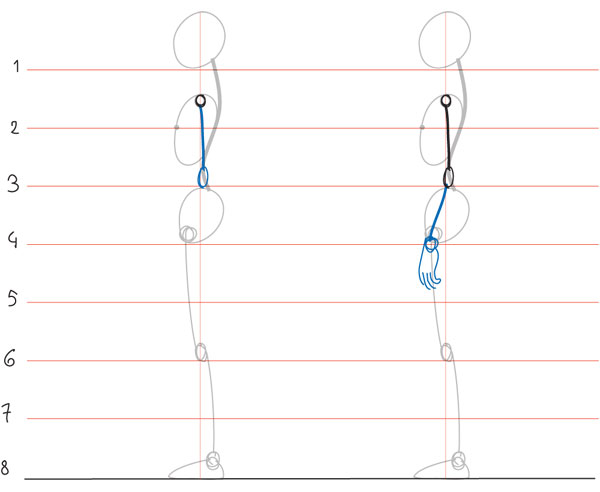


How to Draw a Body: Summary
This completes the basic, undifferentiated human being proportions cartoon tutorial. Hither's a diagram to sum up all the human body outline cartoon techniques we reviewed:
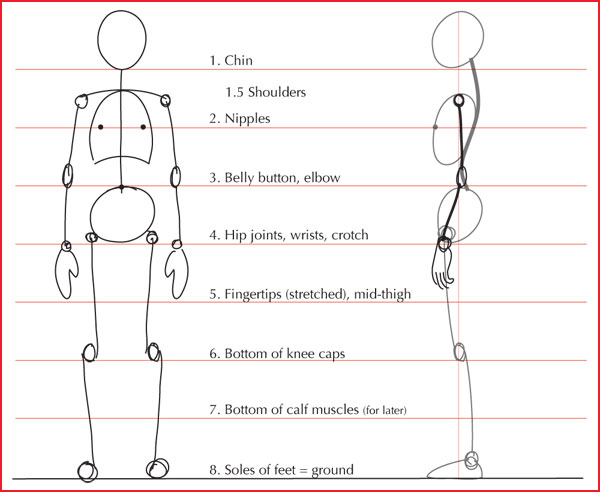


Human Body Proportions Drawing Reminders
The post-obit human proportions drawings are a few useful visual reminders based on the body. They come in handy when the body is not standing upright.



Trunk Cartoon Do Exercises
Nosotros've covered a lot of textile in this body anatomy drawing tutorial. Now is a skilful time to pause the studying and familiarize yourself with this bones figure and the principles of drawing human body proportions. Then, we'll move on to the differences between male and female structures (and others). For instance, you lot tin can integrate this new knowledge into your daily human cartoon sketching practice by overlaying a quick energy sketch with this correctly proportioned basic effigy.
Human being Proportions Drawing Tips
I consistently start with the head, only it doesn't really matter what part of the trunk y'all start drawing, if yous're comfortable and get a adept result. If you're unsure or are having a hard time, then I suggest trying with the head get-go.
Get used to drawing this basic figure with a lite hand, since the finished body will exist built up over it. Traditionally, the final lines are inked and the guidelines then erased (hence the importance of a light hand), simply even when I'grand sketching with a ballpoint pen with the intent of inking on a different sheet by transparency, keeping a light hand ensures I can see what I'm doing.



Discover More Awesome Human Drawing Tutorials
I hope you've enjoyed this tutorial virtually how to draw the human body stride by stride. If you desire to larn even more, nosotros've got this nifty learning guide: Homo Anatomy Fundamentals. There yous'll find detailed human drawing tutorials and resources like these:
Editorial Note: This post has been updated with contributions from Maria Villanueva. Maria is a staff writer with Envato Tuts+.
Source: https://design.tutsplus.com/articles/human-anatomy-fundamentals-basic-body-proportions--vector-18254